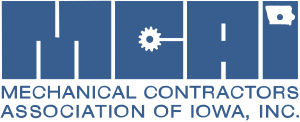NCPWB
Iowa Chapter, National Certified Pipe Welding Bureau
What is the NCPWB? The National Certified Pipe Welding Bureau (NCPWB) is a subsidiary of the Mechanical Contractors Association of America. The Iowa Chapter, NCPWB, is operated by the Mechanical Contractors Association of Iowa. The NCPWB was established to keep contractors informed about welding and brazing technology, and to simplify welding and brazing qualification practices. Contact the Chapter Secretary, Jennifer Adkins, with questions or for additional information.
How does the NCPWB benefit members? Through an extensive library of pre-qualified Welding and Brazing Procedure Specifications (WPS/BPS), members save time, lower costs, reduce the risk of noncompliance, have nationwide access to qualified welder records, and access to technical experts in welding and brazing.
What services are provided by the Iowa Chapter, NCPWB? As the local administer of the NCPWB, the Iowa Chapter, NCPWB provides the following services:
- Employer Witnessing of Welding – In order to meet ASME B31 codes, employers must control and witness welding tests. The Iowa Chapter, NCPWB coordinates with UA Locals 33 and 125 to ensure that employers are present for all tests occurring at their training facilities.
- Continuity Tracking – The Iowa Chapter, NCPWB receives six-month continuity reports for welders from UA Locals 33 and 125, as well as employers. These continuities are uploaded to the NCPWB’s national database as permanent record and available to contractors as proof of the welder’s currency.
- Issuance of Welder Stamp Numbers – In order promote a streamlined system to identify welders throughout the industry, regardless of the contractor for whom they work, the Iowa Chapter, NCPWB issues individual stamp numbers to all welders contained in its database.
- Transfer of Welder Documents – When a contractor hires a new welder who’s enrolled in the NCPWB system, the welder’s records can be transferred to the contractor by the Iowa Chapter, NCPWB. The Iowa Chapter, NCPWB will automatically “push” the documents to contractors if they discover the welder has been hired by a different contractor. Otherwise, documentation is provided to contractors upon request. The transfer of documents literally saves contractors thousands of dollars that they would otherwise spend on conducting welding tests for all newly hired welders. The typical document transferred is the Welder Qualification Test Record with the contractor signature block left blank for the new contractor to sign, thus “transferring” the welder’s certification to the new contractor. Continuity reports are also available upon request.
- Welding and Brazing Procedure Specification Access – The NCPWB offers over a 100 Welding and Brazing Procedure Specifications to members. By having access to this extensive library of pre-qualified WPS/BPS’s, contractors save thousands of dollars. These documents were previously only obtained by contacting the Iowa Chapter, NCPWB, but are now available for download through this website.
- Joint Cooperation with the United Association Welder Certification Program – Although welding tests can be conducted in a contractor’s shop, most tests occur at the UA Local 33 and 125 training centers with their expert instructors, modern testing facilities, and employer witness coordinated by the Iowa Chapter, NCPWB. The NCPWB and UA have partnered to produce over 40 Joint Welding Procedure Qualification Test Records (JPQT). These Welder Qualification Test Records reflect the most common processes used by mechanical contractors.
- Access to Technical Experts – In addition to Iowa Chapter, NCPWB members with extensive welding knowledge, members also have access to the NCPWB’s technical consultant, Walter Sperko, Sperko Engineering.
What is certified welding? The term “certified welding” is widely misunderstood. Certified welding requires that three conditions be fulfilled:
- The Welding Procedure Specification (WPS) has been written to address specific requirements of ASME Section IX and it has been qualified, which means that it has been properly written and weld specimens have passed certain mechanical tests.
- Welder who make production welds have been tested following a qualified WPS, including all of the variables specified by that WPS.
- All qualification records have been signed by a contractor “certifying” that welding of test pieces was done in accordance with the requirements of ASME Section IX.
What’s the most common mistake made by contractors? Hands down, the most common mistake made by contractors is to perform a weld in field with a welder that meets all certification and continuity requirements, but the contractor has never “qualified” the Welding Procedure Specification and signed the Welder Qualification Test Record. Although under ASME B31 series codes, contractors can accept welder certifications from other contractors, the contractor cannot perform that specific weld until they have “qualified” the WPS one time. The contractor must witness and document successful completion of the WPS before they, as a company, can perform that specific welding process.
Services
MCAI Membership
Become an MCAI member today and be part of the mechanical contracting industry’s premier association.
